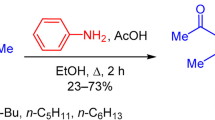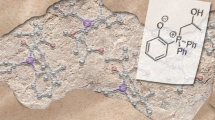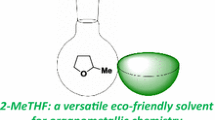Conclusions
-
1.
We have suggested a scheme for the one-electron oxidation of group II OMC by substituted o-quinones.
-
2.
The influence of the nature of the radicals R attached to mercury on the hyperfine coupling constantaHg is related to the changes in the geometric configuration of the
unit caused by changes in the bulk of the substituent R.
Similar content being viewed by others
Literature cited
G. A. Razuvaev, G. A. Abakumov, E. S. Klimov, E. N. Gladyshev, and P. Ya. Bayushkin, Izv. Akad. Nauk SSSR, Ser. Khim.,1977, 1128.
G. A. Abakumov, E. N. Gladyshev, N. S. Vyazankin, G. A. Razuvaev, P. Ya. Bayushkin, and V. A. Muraev, J. Organomet. Chem.,64, 327 (1974).
Chemist's Handbook [in Russian], Vol. 3, Khimiya (1964), p. 957.
Author information
Authors and Affiliations
Additional information
Translated from Izvestiya Akademii Nauk SSSR, Seriya Khimicheskaya, No. 1, pp. 176–180, January, 1978.
Rights and permissions
About this article
Cite this article
Gladyshev, E.N., Bayushkin, P.Y., Abakumov, G.A. et al. Reactions of organometallic compounds and groups with sterically hindered o-quinones. Russ Chem Bull 27, 154–156 (1978). https://doi.org/10.1007/BF01153229
Received:
Issue Date:
DOI: https://doi.org/10.1007/BF01153229




